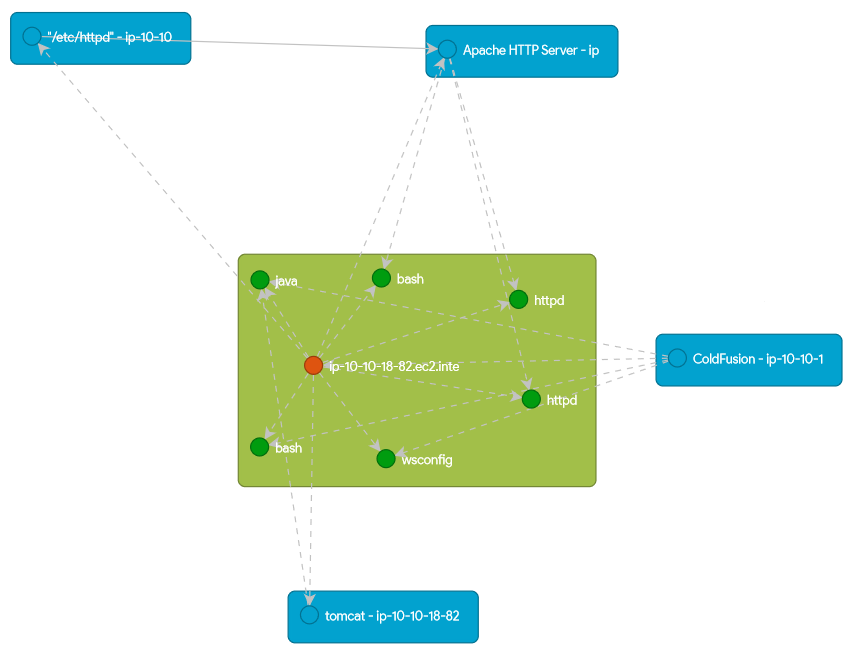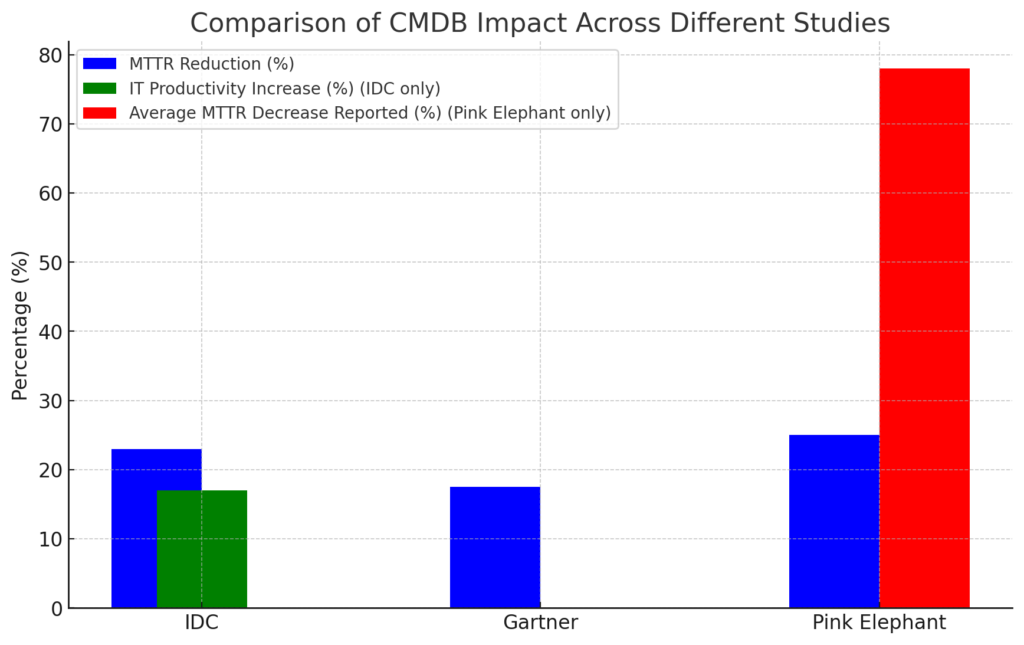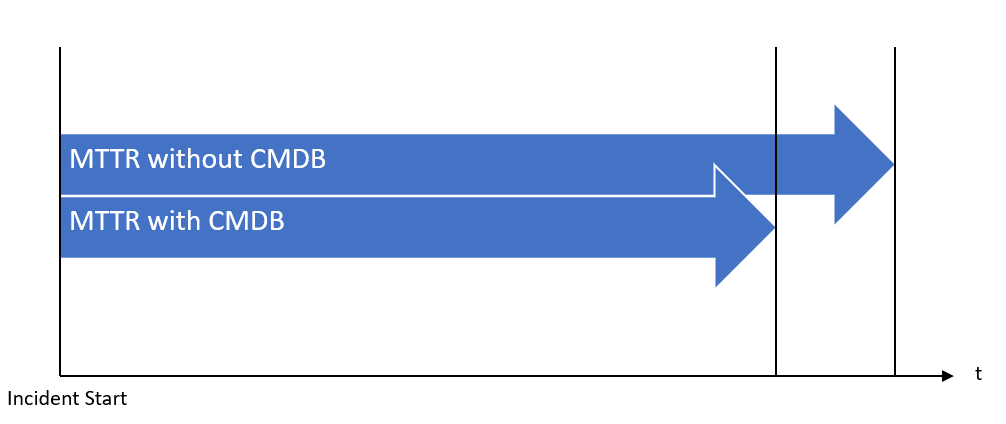Exploring the Top CMDB Benefits for Modern IT Infrastructure
Operational excellence in IT service management can only be accomplished when the organization comprehensively grasps the relationships between IT assets and other associated service elements to deliver IT services that meet user needs. The configuration management database (CMDB) is the vehicle that enables visibility into the IT ecosystem by providing the discovery of configuration items (CIs), whether on-premises or on the cloud, including their attributes and relationships. (It’s worth noting that, according to VeriSM, if an enterprise does not track relationships between CIs, it has an asset register, not a CMDB.)
When a CMDB is working effectively, the organization can achieve maturity in their configuration management practices through better management of IT changes and faster troubleshooting of issues. Managing IT services to perform at the required service levels requires IT to have the right level of visibility into how different applications and infrastructure components work together. To achieve full value from the investment in a CMDB, IT leadership must be clear on the benefits that are to be achieved.
In this article, we explore five benefits that IT can extract from a CMDB solution that is optimally managed to deliver value in IT service management. The focus of this article is mainly on technical benefits, not detailed financial benefits.
Summary of key CMDB benefits
The table below summarizes the five CMDB benefits that are explored in this article.
| Benefit | Description |
|---|---|
| Centralized IT asset information knowledge | Provides a federated repository for information on deployed IT assets to support all operational activities and compliance requirements. |
| Visualization of IT service dependencies | Facilitates easier understanding of IT systems configuration through the visualization of relationships with underlying components and integrations with other services. |
| Faster pinpointing of incident root causes | Enables IT teams to zero in on problematic components, leading to faster incident resolution. |
| More effective change impact analysis | Provides better visibility into potential dependency risks associated with making changes to IT components. |
| Support for regulatory and sustainability compliance | Provides configuration information that facilitates compliance with regulatory requirements and enables sustainability efforts. |
Centralized IT asset information Knowledge
The first benefit of the CMDB is that it provides a single source of truth for all IT asset information. A well-configured CMDB will discover and capture all IT asset information active throughout the network across the IT environment, be it on-premises or in the cloud.
Categories of discovered IT assets include hardware, software, network devices, user devices, and facilities. In addition to the identity of discovered IT assets, the CMDB can also discover underlying information such as operating systems, CPU counts, memory quantities, network addresses, and interconnections.
An appropriate CMDB solution that supports the discovery of all IT assets and associated attributes should include native support for virtualization platforms as well as public and private cloud platforms. By deploying dashboards on the CMDB, an IT team benefits from collaboratively having a unified view of all configuration items drawn from different functions and environments, which enables better planning and operational activities throughout the service lifecycle.
CMDB system administrators can access all discovered CI records and assign additional attributes that raise the value from an operational management perspective. Such attributes include status, ownership, costs, and related records. For example, the status can be updated from “active” to “inactive,” “retired,” or “disposed,” depending on IT asset lifecycle stages. Administrators can assign owners to CIs, such as users of end devices or administrators of systems. Costs related to the procurement of IT assets can also be assigned to individual CIs, with the depreciation and maintenance spend tracked as well. Records associated with the CIs, such as incidents, change requests, and knowledge articles, can also be related.
The effectiveness of IT management is greatly enhanced when this centralized CI information is put in the hands of IT leads involved in both long-term strategic planning and day-to-day IT operations. For instance, decisions on tech refresh are better informed when CI information on status, repairs, and cost of operation is readily at hand.
The CMDB can facilitate the quick identification and analysis of IT assets whose cost of repairs is higher than replacement value, leading to effective decisions on consolidation and retirement. Dealing with vulnerabilities affecting a certain software patch can be made easier by quickly identifying affected instances. In addition, audits for compliance with internal policies, standards, and other frameworks are better conducted when real-time inventory information on CIs is readily available.
Without a well-configured CMDB, the potential for inconsistent and erroneous IT asset information feeding into IT strategies, budgets, and plans could be a recipe for future cost overruns and project failures.
Visualization of IT service dependencies
The adage “a picture is worth a thousand words” comes to mind when thinking about the benefits of an automated CMDB. Once IT assets and their relationships have been discovered, maps of service models that show the dependency connections between configuration items can be generated. The visualization of applications and their dependencies can enable IT administrators and auditors to quickly and conveniently comprehend how IT services and their underlying components have been configured.

A sample application dependency map (source)
A dependency map provides useful information for quickly understanding and tracking particular IT assets as part of service delivery processes. Visualization serves as a crucial unification point when different IT teams plan enterprise architecture and create solution designs. Decisions concerning IT asset criticality and tech refresh are better informed when relevant functions are looking at the same reference for status and dependencies information. For example, the trickle-down effect of a Linux patch or a blade server upgrade on the hosted IT services can be better understood by both applications support and data center operations teams when they all reference the same CMDB dependency map.
A good example of using dependency maps is when planning for migrations between on-premises and cloud environments. If critical dependencies are overlooked, an application migrated to the cloud might not give the performance uplift that the organization is seeking because some key components may remain on-premises, resulting in unwanted latencies that trigger performance degradation. If all the teams involved in planning a cloud migration have a common reference through the application dependency map, the chances of getting it right the first time are greatly enhanced.
Faster pinpointing of incident root causes
An interruption to IT services, be it an outage or drop in performance, is best addressed when speed and accountability are present. The mean time to resolve (MTTR) is a key metric that is usually included in customer service-level agreements and spans the time from detection through response to eventual fixing of the issue. The CMDB is a great aid in meeting MTTR targets as it can facilitate the speedy resolution of incidents by enabling IT teams to pinpoint root causes faster. For example, after receiving several complaints about slowness affecting the CRM service, the IT support team can check the CMDB dependency map to identify the underlying hardware and software elements and dependencies.

Comparison of CMDB impact across different studies
When a complex issue is encountered, an incident-swarming team may be assembled from subject matter experts drawn from different IT functions to troubleshoot the incident symptoms and agree on the right action and team to address the source of the issue. By leveraging the CMDB’s dependency maps, the swarm can reach a point of agreement much faster, thereby locating troublesome components for efficient resolution.

MTTR comparison with and without a CMDB
In addition, once the incident has been handed over to the problem management practice, the CMDB information becomes very useful in the investigation and permanent resolution of incident root causes. Records of incidents associated with certain IT assets can be related within the CMDB, and the problem management practitioners can effectively document workarounds and known errors referencing the affected CIs.
More effective change impact analysis
Changes to IT services and infrastructure are a regular occurrence in the IT environment, driven by the need to meet evolving business and technology requirements such as new functionality and system maintenance. Changes come with inherent risks because failing to plan properly can result in outages, performance degradation, or the introduction of security vulnerabilities. The CMDB can be a valuable resource in reducing the risks arising from the limited visibility of impacted IT components, if it is well utilized during the change planning process.
When the CMDB is fully populated with relevant CIs involved in the change, and includes the dependency mapping, then the planners can run an automated impact analysis to determine the potential impacts, such as service outages or degradation. The output of such a report would include a list of all the CIs likely to be impacted by the proposed change, including services, as well as the relative impact based on scales of degree, e.g., high, medium, or low. With such information, both planners and change authorities can more confidently make decisions on determining the risks associated with proposed changes. There would be no need to hold a long and tedious change advisory board (CAB) forum with multiple dissenting options on the potential impact of a planned change because the CMDB would be the single source of truth about the effect on existing IT services.
Dependency maps can be a good reference for change planners and authorities whenever they are discussing planned changes. It becomes easier for teams to agree on decisions about changes when they reference their single point of truth that scales their entire IT ecosystem. In addition, once the changes have been carried out, the post-implementation review is better informed by using CMDB information when highlighting the actual impact on dependent services and components. Dependency maps can visualize the status before, during, and after the IT systems updates, and where change-related incidents occur, the associated incident records can be related to the affected configuration items through the CMDB.
Support for regulatory and sustainability compliance
Social responsibility is becoming a key consideration for IT functions owing to their impact on areas such as climate change and data privacy. The need for compliance and sustainability continues to increase as IT becomes more complex.
The CMDB is a valuable tool that can support compliance efforts by providing visibility into IT configuration issues that could lead to noncompliance. For example, suppose an existing IT service is being audited for potential data privacy violations. The CMDB can be leveraged to show visibility about the flow of data into and out of the IT service so that all related databases and interfaces are identified and checked to ensure that the relevant privacy controls are in place. Such visibility can be crucial, especially with the hefty regulatory fines facing noncompliant firms such as those related to the GDPR. The right CMDB solution should be quick and easy to deploy for discovery so that it is always audit-ready for compliance purposes.
In the area of sustainability, the CMDB can benefit organizations when it comes to matters concerning the environmental impact of IT. For instance, the need to reduce carbon footprint by effectively using power resources would require a detailed inventory of which services are using which IT assets before determining how hungry for energy they are and techniques to optimize their power efficiency. Initiatives such as server consolidation and application portfolio downsizing can only generate the highest levels of power and associated cost savings when informed by accurate IT asset data. The CMDB can be that reference for identifying the configuration items that impact power usage. The same CMDB capability can be used to determine which IT assets are inactive and need to be decommissioned and disposed of in an environmentally safe manner.
Recommendations
For the CMDB to deliver the benefits outlined above, the configuration management process should be well executed. Apart from assigning responsibility for managing the CMDB, IT functions must endeavor to update the CMDB data through automated discovery and regular audits. According to a study by Gartner, 99% of organizations using CMDB tooling that do not confront data quality gaps will experience visible business disruptions by the end of 2024. The gap between the actual configurations and what is in the CMDB can make a significant difference in whether the organization obtains value from its investment.
In addition, the IT function must invest in training its staff members on how to effectively use the CMDB in all ITSM practices. For staff to reference the CMDB daily as its point of reference, team members must be equipped with the requisite knowledge and influenced by IT leadership to maximize the CMDB throughout the IT service lifecycle. Without the right skills, the chances of gaining the outlined benefits from the CMDB are very low.
Final thoughts
It would be hard to overemphasize how beneficial a well-functioning CMDB is to IT firms. Maturity in service management requires IT teams to have the right information at hand when planning, operating, and improving their IT services and systems.
An enterprise’s IT goals for operational excellence can only be achieved when the CMDB is fully operational, accurate, and utilized by all IT staff as their single point of truth. Device42 realizes the importance of CMDB for modern businesses and offers an all-encompassing platform that goes beyond basic data aggregation to offer a number of features:
- Automatic discovery and inventory
- Visual dependency mapping
- Real-time monitoring and alerting
- Powerful reporting and analytics
But don’t just go by our word. Learn how:
- SoftBank Corp leveraged Device42 for automated discovery, inventory, and data integration to achieve 25% cost reduction over 5 years, increased automation to 95%, and significant reduction of support requests.
- Imperial College London utilized Device42’s real-time monitoring and alerting capabilities for proactive issue identification and resolution; resulting in improved uptime, faster incident response times, and enhanced staff confidence in system reliability.




